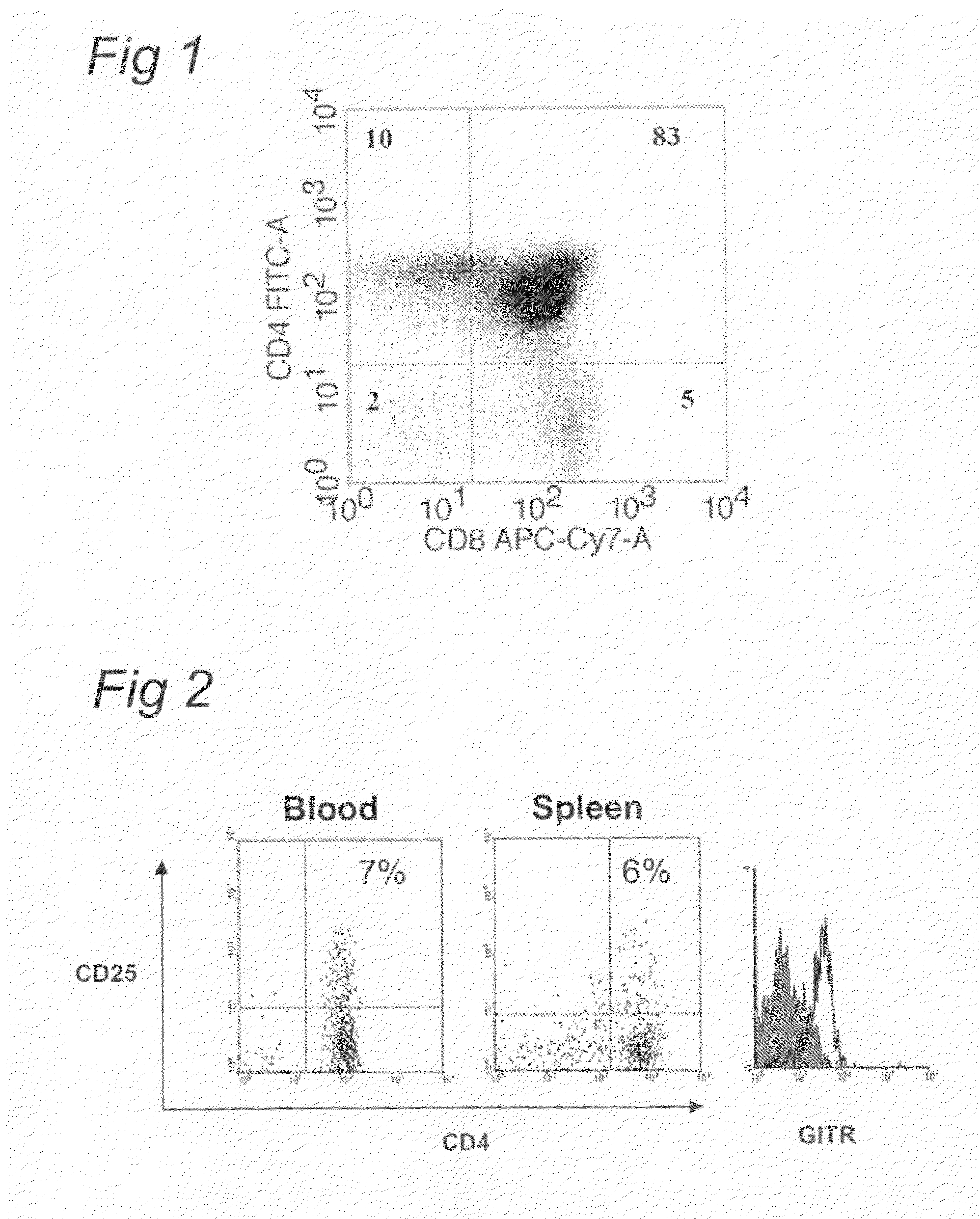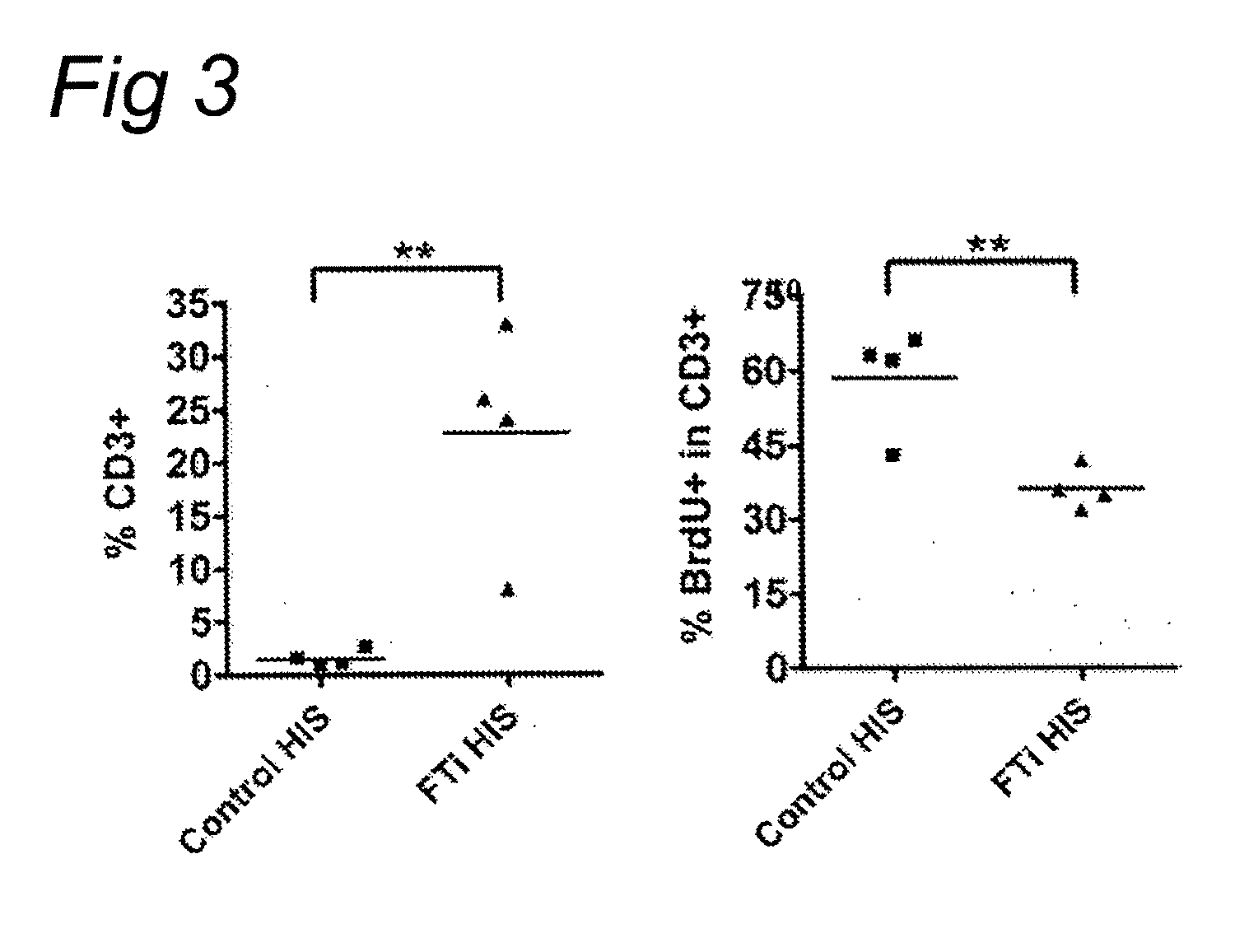[0036]Alternatively or in combination with earlier defined preferred embodiments, the xenogenic composition comprising parts of thymus further comprises parts of xenogenic
spleen and / or parts of xenogenic
skin. Xenogenic
spleen and
skin preferably originate from the same individual as the thymus, liver and
bone marrow. Each piece of
spleen is approximately a cube of 1 to 2 mm side, the surface of transplanted
skin is approximately a square of around 5 mm side (after removal of an equivalent surface of recipient
animal skin). Xenogenic spleen is advantageous for further improving the reconstitution of xenogenic B cells. Xenogenic skin is attractive to be present in the
animal model prepared carrying out the method of the invention for specific applications of the animal model such as monitoring cutaneous immunization of the animal model for a specific administered
infectious agent.
[0046]Another of these pretreatment steps is the engraftment of the first xenogenic composition comprising parts of xenogenic thymus (step e). The engraftment may be carried out under the
kidney capsule of the mouse. Alternatively, the engraftment may be intra muscular,
intra peritoneal or subcutaneous. In a preferred embodiment, the engraftment is subcutaneous. Subcutaneous engraftment has already been successfully used in the
SCID mice (Mc Cune J. M., et al, 1988, Science, 241: 1632-1639). It is a relatively easy engraftment technique which has the
advantage of being
less invasive for the engrafted recipient animal than other classical non-subcutaneous engraftment techniques. Briefly, an incision is made on the skin on the back of the mouse, parts of xenogenic thymus and optionally liver or others tissues as earlier defined herein are inserted under the skin with
forceps. Some
Matrigel™ Matrix (
basement membrane matrix, Becton Dickinson) could be applied to glue all pieces together in the same area under the skin and to improve vascularisation. Finally the skin is closed again.
[0054]A most preferred animal obtainable by the method of the invention is a RAG2 and IL2Rγ
deficient mouse subcutaneously engrafted with parts of human thymuses and liver tissues and containing human CD34+ progenitors. This animal model for the production of a xenogenic immune
system constitutes an improvement over known animal models since it allows both a quantitative and qualitative improvement of the recovered xenogenic immune cells. The
main effect is as expected an accumulation of T cells (20-30 fold increase in absolute
cell numbers) with a longer survival capacity, as described more precisely in the supporting data enclosed in this document. The presence of the thymic transplant in hematopoietic stem cells inoculated Rag-2 IL-2Rγc deficient mice [HIS (Rag / γ)] does not only
impact positively on human
T cell life-span and accumulation. The absolute
B cell numbers in the spleen of HIS (Rag / γ) mice with a thymic transplant were also increased around 2-fold, as compared to a 25-fold increase in T
cell numbers (see Table in the results section).
[0055]This accumulation of B cells is expected, due to several factors in relation to T
cell accumulation. First, T cells produce soluble factors which participate to
B cell proliferation and function, and vice-versa, with stimulatory, differentiation and chemo-attraction effects. As far as
B cell differentiation is concerned, it is known that the so-called “helper” CD4+ T cells are required for immunoglobulin
isotype switch. An increased amount of long-lived T cells ultimately leads to higher chances to produce and accumulate switched B cells, in particular “memory” IgG-producing B lymphocytes. Second, it is known that secondary lymphoid organs (e.g. spleen) are disorganized at least partially during lymphopenic conditions, which are observed in the classical HIS (Rag / γ) mice without thymic transplant. The accumulation of lymphocytes is leading to increased
structural organization of the lymphoid organs, and this contributes to increased survival of lymphocytes in situ. Last, the human thymic transplant itself contributes to the global “welfare” of human lymphocytes in the mouse environment. Indeed, it is known that thymic epithelial cells produce growth and survival factors involved in development and survival of lymphocytes, of which IL-7 is a major contributor. Therefore, IL-7 production by epithelial cells of the thymic transplant and subsequent release in the circulation may
impact positively on the global survival state of human lymphocytes developing in humanized mice.
[0056]It can be excluded that other
human cell lineages are also positively affected, since IL-7 is also a
stem cell survival factor. Furthermore, a new subset of thymus-derived Natural Killer (NK) cells expressing the IL-7
receptor was recently identified (Vosshenrich C. et al, 2006, Nat. Immunol., 7: 1217-1224). The additional thymic transplant will therefore contribute to increased production and seeding of IL-7R+ human NK cells in HIS (Rag / γ) mice.
 Login to View More
Login to View More 

